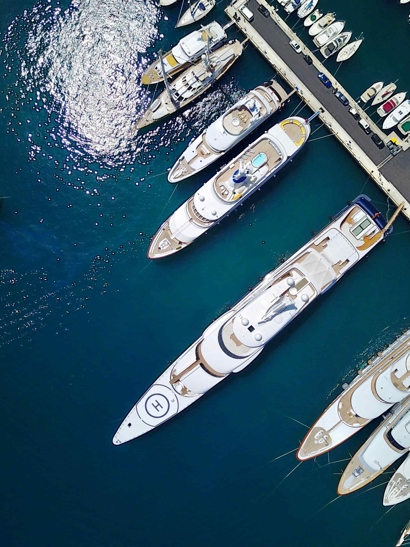Part of the new construction team at Burgess, Edmund Beckett and Nathan Durley-Boot know only too well the difference between building a yacht to meet operational requirements and building a yacht to meet owner expectations. “Often an owner won’t get directly involved in regulatory decisions beyond which yacht code to build to and which classification society to choose,” explains Beckett. “What really concerns them directly is to do with functionality, performance, and enjoyment of the vessel.”
Comfort
Enhancing the guest experience onboard is the biggest focus when it comes to designing and building beyond rules and regulations. Whether it’s through equivalent arrangements to avoid impractical requirements, such as the height of coamings on doors, unusual glass features like underwater windows or through advanced technology and systems, such as stabilisers, onboard comfort is a key priority for any superyacht project.
“Noise and vibration performance is a prime example of where there are certain requirements to satisfy crew working conditions, but a superyacht project will take it a step further,” advises Durley-Boot. “The emphasis is on reducing noise and vibration at source; ensuring machinery foundations are of high stiffness, incorporating acoustic enclosures around generators and resilient mounts for machinery. A lot of work also goes into optimising the design of the propeller.”
Air conditioning is another area of onboard comfort that is specified to a far greater standard than is defined by the rules and regulations. Not only does a superyacht HVAC installation need to maintain a comfortable interior climate, but the way this is achieved is equally important. Significant attention is paid to minimising the sound of air running through the ducts, as well as the positioning of the air conditioning vents to avoid draughts and visible eyesores. Furthermore, the treatment of the air goes far beyond any regulatory standard.

“The superyacht industry presents an opportunity for the maritime industry as a whole – it’s developing technology that all sectors can benefit from.”
Redundancy
A system failure onboard a superyacht can cause significant disruption and cost, particularly during a charter, so another aspect is ensuring all systems have appropriate redundancy. “Various different systems can utilise common spare parts so that there is built-in redundancy in that respect,” says Durley-Boot. “We can try to sensibly introduce margin to systems as well.”
When it comes to redundancy, however, a balance must be struck so as not to compromise the design of the yacht in anyway. “Depending on the client’s priorities, it’s about safeguarding the performance of the systems that are the most critical,” adds Beckett. “This can be a challenge if you don’t have the space, or the owner’s or shipyard’s appetite, to increase complexity and costs.”
Aesthetics
As an ultimate form of luxury, almost every element of the visual look of a superyacht goes beyond any rules and regulations. Arguably, nothing causes quite as much scrutiny as the exterior paint finish. While there are certain functional requirements that must be met, much of the focus of a paint job is directed towards the aesthetic quality, often resulting in an arduous negotiation process surrounding the acceptance criteria.
“The attention to paint happens quite early on in the build because the structure of the vessel needs to be correct so as not to impact the thickness of the filler, which in turn can impact the look of the paint over time,” explains Durley-Boot. “A Lloyd’s Register surveyor might approve of the alignment of the construction and the way it’s been fabricated, but it might be completely unacceptable to the client from a fairing and painting perspective.”
Operations
The new construction team at Burgess can be faced with designs that don’t provide a safe working environment, or the risks aren’t as low as reasonably practicable. This usually leads not only to a discussion with the shipyard, class and flag, but also a negotiation with the designers who are representing the owner’s interests in terms of styling, layout and lifestyle.
Mooring area design, for example, has been an unregulated element of yacht design for a long time, yet it relates to one of the most hazardous operations that a crewmember will undertake. “There is often tension around mooring areas where designers want to conceal equipment or make the space very compact, which might mean a crewmember working in a confined space with lines under tension,” continues Beckett. “It’s our responsibility to rally all the parties involved to ensure we get it right.”

Sustainability
While there are incoming regulations aimed at reducing the maritime industry’s environmental impact, most will not be applicable to the superyacht industry. Therefore, the extent to which each new construction project incorporates sustainable solutions becomes an individual decision for the client. As such, the Burgess new construction team often provide guidance on the best approach, aligned to the client’s viewpoint.
“Superyachts were some of the first vessels to incorporate large battery banks and operate on hybrid propulsion, and there are currently projects in build adopting alternative fuels,” highlights Durley-Boot. “The superyacht industry presents an opportunity for the maritime industry as a whole – it’s developing technology that all sectors can benefit from.”
Whether it relates to comfort, redundancy, operations, aesthetics, or sustainability, superyacht projects are pioneers in terms of ship design and construction. With every project, it’s important the client doesn't feel constrained by regulations, and that their expectations are fulfilled in the most effective way. The challenge for the design and construction teams is interpretating those expectations and translating them into a working reality. As such, a collaborative approach is essential, whereby the owner’s team, designer, shipyard, and classification society interact throughout with the shared goal of building a superyacht that is as good as it can possibly be.







